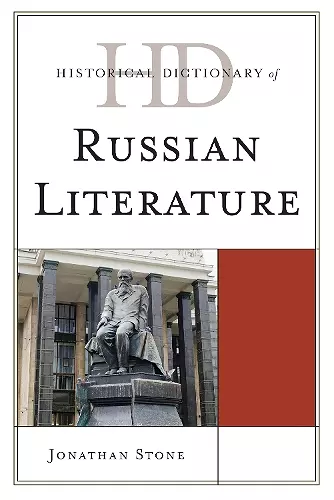Historical Dictionary of Russian Literature
Format:Hardback
Publisher:Scarecrow Press
Published:3rd Dec '12
Currently unavailable, and unfortunately no date known when it will be back

Russian literature is most celebrated for its Romantic and modernist poetry and 19th-century novels. While literary traditions of varying sorts have been part of Slavic and Russian culture for over a millennium, it is only since the 18th century that they came to resemble literature from the West.
The Historical Dictionary of Russian Literature contains a chronology, an introductory essay, appendixes, and an extensive bibliography. The dictionary section has over 100 cross-referenced entries on significant people, themes, critical issues, and the most significant genres that have formed Russian Literature. This book is an excellent access point for students, researchers, and anyone wanting to know more about Russian literature.
Russian literature has an illustrious history. This Historical Dictionary of Russian Literature strives to give the reader a grasp of that history. This valuable reference work opens with a year-by-year chronology starting with a sacred text introducing the written alphabet in ca.860 and ending in 2010 with Putin's proposal to compile a canon of 100 books that every Russian school child must read and be tested on. This chronology is followed by an extensive narrative essay that discusses Russian literature's evolution during various literary time periods, including the romantic era, modernist poetry, and nineteenth-century novels.
The heavily cross-referenced historical dictionary deals with poetry, novels, historical narratives, philosophical writings, and dramas....There is an extensive bibliography organized around the historical eras found in the introductory narrative essay....A superb, well-written, interesting book. The scholar as well as the casual reader will certainly learn a great deal about one of the foundations of Russian literature.
Stone (Russian studies, Franklin & Marshall Coll., Lancaster, PA) brings an overview of Russian literature to the “Historical Dictionaries of Literature and the Arts” series. The entries include authors (Dostoyevsky, Turgenev, Gogol), titles (Anna Karenina, Dead Souls, Brothers Karamazov), and periods (Romanticism, Realism, Modernism). Genres (The Novel, Poetry) are explored along with groups/concepts (Formalism, Symbolism). Terms that appear in bold have their own entries. Stone mentions in the preface that “this is intended to complement” other more detailed works on the subject (e.g., Victor Terras’s Handbook of Russian Literature). The information here is in brief articles and a helpful chronology establishes the historical time line. Through extensive bold items and cross referencing, the reader is led through a sampling of Russian literary topics, creating an atmosphere that will engage students to learn more. Some interesting facts include Doctor Zhivago actually being published in Italy and that the poet Esenin was once married to Isadora Duncan and met a tragic end. Other intriguing entries are acmeism, samizdat, and sections devoted to women (Women in Russian Literature, Women’s Writing). Censorship, Stalinism, and Solzhenitsyn are also covered. The appendix offers “Russian Names and Titles” in both English and Russian. Some alternate spellings are shown, for example, “Tolstoi, Lev Nikolaevich (Alt. Tolstoy).” The sizable bibliography is divided into subject and author categories, which is useful. This would be a good companion to an Introduction to Russian Literature course. VERDICT Great for students, of interest to those who enjoy Russian literature, and a handy reference tool. * Library Journal *
With more than 100 extensively cross-referenced entries ranging from Acmeism (a facet of Russian
modernism) to the depiction of women in Russian literature, this book is intended as an introduction to the subject for the casual student. An introductory essay acquaints readers with the major periods of Russian literature and is followed by a chronology (beginning in the twelfth century) of the movements, genres, works, characters, and authors considered pivotal to its study. There is an appendix of Russian names and titles as well as several bibliographies grouped chronologically, thematically, and aesthetically. This is an excellent starting point for beginning research of Russian literature and is recommended for most libraries.
Many entries in this historical dictionary by Stone (Franklin & Marshall College) are biographical, but a fair number explore literary styles and trends, and schools of criticism. Entries date back to the early 1700s, and press forward into contemporary times. However, most entries talk about Russia's Golden Age of Literature, from the mid to late 19th century. Entries are dense, complex, and intricate; they are appropriate for students and scholars of Russian literature who are emphasizing literary criticism and theory. The entries live up to the author's declared intention to have them function independently, but they also serve as a web of interconnected themes and ideas. One major theme emergent in this dictionary is the old but still true idea that some of the best Russian literature negotiates encounters with Western ideas and aesthetics, while seeking always to help mold and comprehend its own unique cultural identity. The dictionary comes with a strong introduction, which divides Russian literature into different epochs and attempts to flesh out the singular character of each. Summing Up: Recommended. Graduate students and researchers/faculty. * Choice Revie
ISBN: 9780810871823
Dimensions: 234mm x 160mm x 29mm
Weight: 608g
312 pages